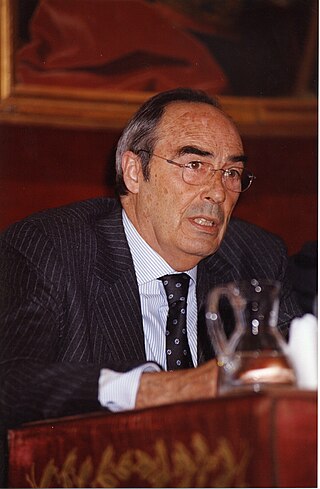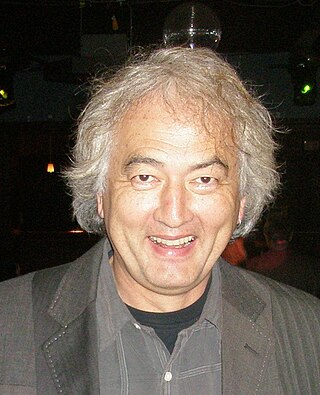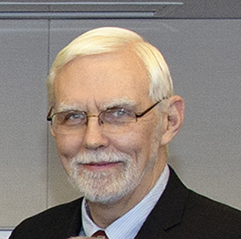Related Research Articles

In theoretical physics, quantum chromodynamics (QCD) is the study of the strong interaction between quarks mediated by gluons. Quarks are fundamental particles that make up composite hadrons such as the proton, neutron and pion. QCD is a type of quantum field theory called a non-abelian gauge theory, with symmetry group SU(3). The QCD analog of electric charge is a property called color. Gluons are the force carriers of the theory, just as photons are for the electromagnetic force in quantum electrodynamics. The theory is an important part of the Standard Model of particle physics. A large body of experimental evidence for QCD has been gathered over the years.

In physics, lattice gauge theory is the study of gauge theories on a spacetime that has been discretized into a lattice.

In particle physics, a glueball is a hypothetical composite particle. It consists solely of gluon particles, without valence quarks. Such a state is possible because gluons carry color charge and experience the strong interaction between themselves. Glueballs are extremely difficult to identify in particle accelerators, because they mix with ordinary meson states. In pure gauge theory, glueballs are the only states of the spectrum and some of them are stable.

Lattice QCD is a well-established non-perturbative approach to solving the quantum chromodynamics (QCD) theory of quarks and gluons. It is a lattice gauge theory formulated on a grid or lattice of points in space and time. When the size of the lattice is taken infinitely large and its sites infinitesimally close to each other, the continuum QCD is recovered.
Quark matter or QCD matter refers to any of a number of hypothetical phases of matter whose degrees of freedom include quarks and gluons, of which the prominent example is quark-gluon plasma. Several series of conferences in 2019, 2020, and 2021 were devoted to this topic.
Farid F. Abraham is an American scientist.
The J. J. Sakurai Prize for Theoretical Particle Physics, is presented by the American Physical Society at its annual April Meeting, and honors outstanding achievement in particle physics theory. The prize consists of a monetary award (US$10,000), a certificate citing the contributions recognized by the award, and a travel allowance for the recipient to attend the presentation. The award is endowed by the family and friends of particle physicist J. J. Sakurai. The prize has been awarded annually since 1985.
The MIT Center for Theoretical Physics (CTP) is the hub of theoretical nuclear physics, particle physics, and quantum information research at MIT. It is a subdivision of MIT Laboratory for Nuclear Science and Department of Physics.

Norman Howard Christ is a physicist and professor at Columbia University, where he holds the Ephraim Gildor Professorship of Computational Theoretical Physics. He is notable for his research in Lattice QCD.

Quark–gluon plasma is an interacting localized assembly of quarks and gluons at thermal and chemical (abundance) equilibrium. The word plasma signals that free color charges are allowed. In a 1987 summary, Léon van Hove pointed out the equivalence of the three terms: quark gluon plasma, quark matter and a new state of matter. Since the temperature is above the Hagedorn temperature—and thus above the scale of light u,d-quark mass—the pressure exhibits the relativistic Stefan-Boltzmann format governed by temperature to the fourth power and many practically massless quark and gluon constituents. It can be said that QGP emerges to be the new phase of strongly interacting matter which manifests its physical properties in terms of nearly free dynamics of practically massless gluons and quarks. Both quarks and gluons must be present in conditions near chemical (yield) equilibrium with their colour charge open for a new state of matter to be referred to as QGP.

Francisco José Ynduráin Muñoz was a Spanish theoretical physicist. He founded the particle physics research group that became the Department of Theoretical Physics at the Autonomous University of Madrid, where he was a Professor. He was described by his colleagues as "a scientist that always searched for excellence in research".
Donald Henry Weingarten is a computational physicist.

John William Harris is an American experimental high energy nuclear physicist and D. Allan Bromley Professor of Physics at Yale University. His research interests are focused on understanding high energy density QCD and the quark–gluon plasma created in relativistic collisions of heavy ions. Dr. Harris collaborated on the original proposal to initiate a high energy heavy ion program at Cern in Geneva, Switzerland, has been actively involved in the CERN heavy ion program and was the founding spokesperson for the STAR collaboration at RHIC at Brookhaven National Laboratory in the U.S.
Alfred H. Mueller is an American theoretical physicist, and the Enrico Fermi Professor of Physics at Columbia University.

G. Peter Lepage is a Canadian American theoretical physicist and an academic administrator. He was the Harold Tanner Dean of the College of Arts and Sciences at Cornell University from 2003 to 2013.
The Herman Feshbach Prize in Theoretical Nuclear Physics is a prize awarded annually by the American Physical Society to recognize and encourage outstanding achievements in theoretical nuclear physics. The $10,000 prize is in honor of Herman Feshbach of MIT. The prize, inaugurated in 2014, is awarded to one person or is shared among two to three persons when all of the recipients are credited with the same accomplishment.
Xiangdong Ji is a Chinese theoretical nuclear and elementary particle physicist. He is a Distinguished University Professor at the University of Maryland, College Park.
Claude Pruneau is a Canadian-American experimental high-energy nuclear physicist. He is a professor of physics at Wayne State University and the author of several books. He is best known for his work on particle correlation measurements in heavy ion collisions at the Relativistic Heavy Ion Collider and the Large Hadron Collider.
Heinrich Leutwyler is a Swiss theoretical physicist, with interests in elementary particle physics, the theory of strong interactions, and quantum field theory.
Larry D. McLerran is an American physicist and an academic. He is a professor of physics at the University of Washington.
References
- 1 2 "Michael Creutz: Resume" . Retrieved 5 September 2010.
- ↑ Gonzalez, Blanca (July 13, 2009). "Obituary: Edward Creutz; worked on Manhattan Project". Sign On San Diego.
- ↑ "Ed Creutz: 1/23/1913 -- 6/27/2009" . Retrieved 5 September 2010.
- ↑ "Michael Creutz : Publications" . Retrieved 5 September 2010.
- ↑ "2000 Aneesur Rahman Prize for Computational Physics Recipient". APS. Retrieved 5 September 2010.